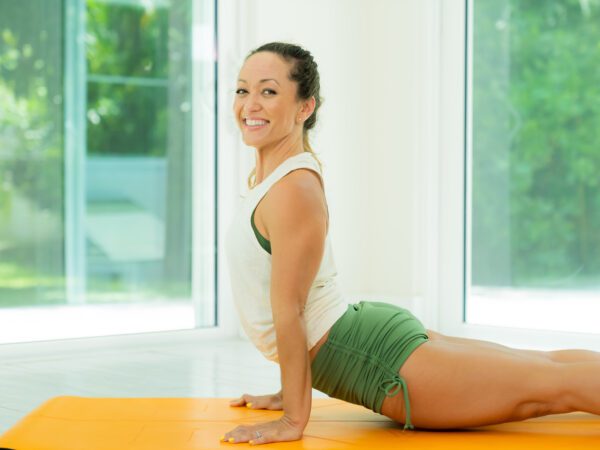The way we practice, why we get on our mats, the directions we explore to experience something. There are so many possibilities. Do the differences matter? I think so. Whatever it is that’s getting you onto your mat or guiding your explorations needs to feed your soul. If it doesn’t, then we risk losing the motivation to practice and assume that means “it’s just not for me.”
Think about the first time you fell in love with the practice. Did you need to find the motivation to go back to class? It seems to be less about cultivating discipline and more about stripping the practice down until all you’re left with is love for it because this practice really is an experience to fall in love with. We step on our mats because we want to. We want to experience the movement of energy and feel what’s going on beneath the surface. There will be moments of difficulty but if love is there, we’ll have the courage to go into those moments. For me, the process of coming back to a place of love for this practice when I’ve forgotten involved simplifying the practice, slowing it down and making it less physically intense so I could allow space for genuine connection to the practice to take root again. Many times it was about re-discovering the depth and potency of surya namaskara and allowing that to support the rest of the practice.
Don’t practice because you’re bad, and it’ll make you good, a mindset that takes us out of the present and further from where we are right now. Practice because the experience itself is pulling you towards it. Whatever that means for you on any given day. Whatever length of time that means. It doesn’t matter. What matters is that we’re making it to the mat to explore and hold the body in ways that facilitate more balanced pathways. We’re restructuring those energy pathways in subtle ways so that new patterns of relating to ourselves and the world show up off the mat in more tangible ways.
We don’t need to cultivate the discipline to practice 6 times a week because we should. We’re falling in love with the breath, tapping into a curiosity for it so that when a new day starts, we want to greet it by stepping on the mat – a space to connect to it more openly and meet ourselves exactly where we are. To feel what the breath is telling us in each moment. To settle into each moment and stay open to its spontaneous unfolding, rather than keep our sights outwards on where we think we should be.
If that genuine excitement and curiosity is there, you don’t need a structure telling you when to practice. I think that’s the potential danger in following a structure or format for practice too rigidly – you’re told exactly what to practice and when to practice it and how many postures to do each day. Following a specific structure that’s been given to everyone can distract you into applying the effects of a practice without connecting with the cause of it; without going in to do the work yourself and allowing whatever comes from that process to inform what the practice looks like on the outside. Applying aesthetic – like length of time you’re on the mat and external form – from the outside in will burn you out. For most people, it’ll eventually take them to a place where they feel they have to practice and forget why they fell in love in the first place.
Find what naturally pulls you to your mat, don’t just adopt a reason because someone who you think is spiritual said it was their reason. It can be to experience the intelligence of the breath or energy moving in sensation. It can be to feel the body opening and stabilizing. Or something totally different and unique to you. Then, allow the practice to look however it needs to in order to connect to that curiosity and interest. At first, they might seem like simple things, but that’s the mindset yoga is bringing us back to. One that is in awe of the simplest and most seemingly mundane things. Like a child, we go back to our roots. Go back to the foundations in asana and find out for yourself how exciting they can be. Deconstruct the basics, take them apart, stay a little longer than you normally would, move into them using a new approach. What do you find? Look again. And then don’t stop looking again because that process IS the practice, and that’s where you’ll find the inclination to get back on the mat tomorrow. Who knows maybe it’ll make you want to start practicing asana 6 days a week. Maybe not.
If the genuine desire to practice isn’t there, then ask yourself why. If something feels off in the practice, it’s because something probably is. For me, when I’ve been in unmotivated moments, it’s been because I’m doing more than I should be doing. Pushing my body to do a practice that, when I looked closer, was too much physically during a particular time in my life. I was in pain and left feeling depleted. If you’re down, in pain, or going through something hard in your life, let the asana practice be soft and perhaps shorter. Allow yourself to feel those things. Let them in to allow the practice to be a reflection of where you are. Don’t force the practice to be a reflection of where you think you ‘should’ be. The path of pushing through and enduring doesn’t work long term.
Other times the practice felt forced because I was doing things off the mat that didn’t support a healthy body and mind. In that way, the practice becomes a mirror for what I was doing outside asana practice, a space for compassionate confrontation. A gentle reminder that we should make the effort to practice yoga all day. On the mat, if we’re open to feedback, we’ll be guided into developing a practice that uniquely works for us and one that can blossom into a state we tap into all the time, in everything we do.

Practice LIVE on Omstars with Monica Arellano
Monica Arellano is a Level 2 Authorized teacher in the Ashtanga Yoga Method; a formal blessing received by her teacher R. Sharath Jois in Mysore, India. She first connected to the practice of yoga in 2010, looking for a more peaceful way of being. When she found her way to Miami Life Center in 2014 she began a regular Ashtanga Yoga practice and soon after completed a 2 year apprenticeship program under Tim Feldmann. Today she continues to practice, teach and travel regularly to Mysore, India to learn yoga directly from the source. Monica’s teachings are informed by the knowledge carried on from her teachers and the first-hand experience from her daily asana and meditation practice. Her classes emphasize the breath, alignment, and methods of concentration; in hopes of exploring the deeper experience of asana and the resulting expression in each student’s unique and mind. In this space, she believes we can deconstruct unhealthy patterns, facilitate healing on many levels, and find our way back to the most honest version of ourselves.
This blog was originally posted on monicarellano.com










